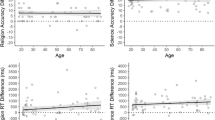Abstract
Two types of meaning representation are described, symptom and criterion, and it is argued that both have psychological status in mental representations of kinship terms. Certain symptoms, such as old age and biofocals for grandmothers, are likely indicators of grandmotherhood, but they do not reliably pick out all positive instances, nor do they indicate negative ones. Criteria specify the necessary and sufficient conditions for grandmotherhood: having a grandchild. The psychological reality of these two representations was demonstrated by asking children and adults to select kin-term exemplars from pictures in which both age and reciprocal kin symptoms are displayed, and to justify their selections. In both tasks, there was change with age away from using typical age as the sole basis for performance; older subjects selected pictures displaying reciprocal kin, and justified their choices by referring to the criterion. More important, at each age level, there was evidence for dual representation: Even subjects who selected pictures based on the age symptom often gave criterial justifications, and subjects who selected pictures based on the reciprocal kin symptom still preferred pictures displaying age symptoms in addition to the reciprocal kin.
Similar content being viewed by others
References
Armstrong, S. L., Gleitman, H., & Gleitman, L. R. What some concepts might not be. Forthcoming.
Carey, S. Semantic development. In L. R. Gleitman & E. Wanner (Eds.),Language acquisition: State of the art. Cambridge, Massachusetts: Harvard University Press in press.
Clark, E. V. What's in a word? On the child's acquisition of semantics in his first language. In T. E. Moore (Ed.),Cognitive development and the acquisition of language. New York: Academic Press, 1973.
Kripke, S. Identity and necessity. In S. P. Schwartz (Ed.),Naming, necessity, and natural kinds. Ithaca, New York: Cornell University Press, 1977.
Piaget, J.Judgment and reasoning in the child. Totowa, New Jersey: Littlefield, Adams, 1972. (Originally published, 1928.)
Putnam, H. Meaning and reference. In S. P. Schwartz (Ed.),Naming, necessity, and natural kinds. Ithaca, New York: Cornell University Press, 1977.
Rosch, E. H. On the internal structure of perceptual and semantic categories. In T. E. Moore (Ed.),Cognitive development and the acquisition of language. New York: Academic Press, 1973.
Rosch, E., & Mervis, C. B. Family resemblances: Studies in the internal structure of categories.Cognitive Psychology, 1975,7, 573–605.
Smith, E. E., Rips, L. J., & Shoben, E. J. Semantic memory and psychological semantics. In G. H. Bower (Ed.),The psychology of learning and motivation (Vol. 8). New York: Academic Press, 1974.
Wittgenstein, L.The blue and brown books (1933–1935). New York: Harper & Row, 1958.
Author information
Authors and Affiliations
Rights and permissions
About this article
Cite this article
Landau, B. Will the real grandmother please stand up? The psychological reality of dual meaning representations. J Psycholinguist Res 11, 47–62 (1982). https://doi.org/10.1007/BF01067501
Accepted:
Issue Date:
DOI: https://doi.org/10.1007/BF01067501




